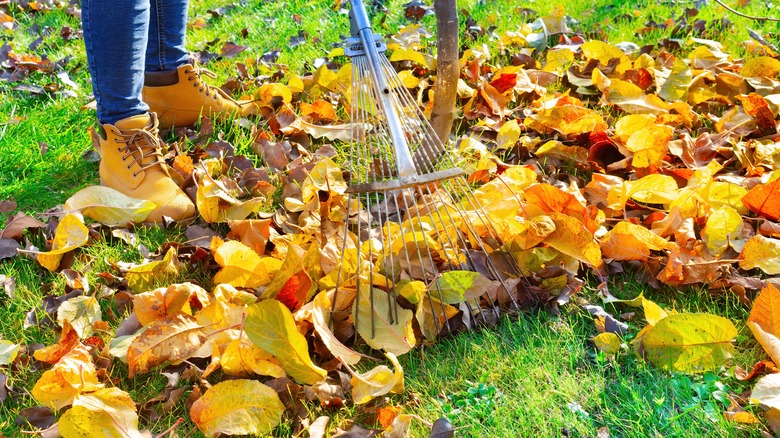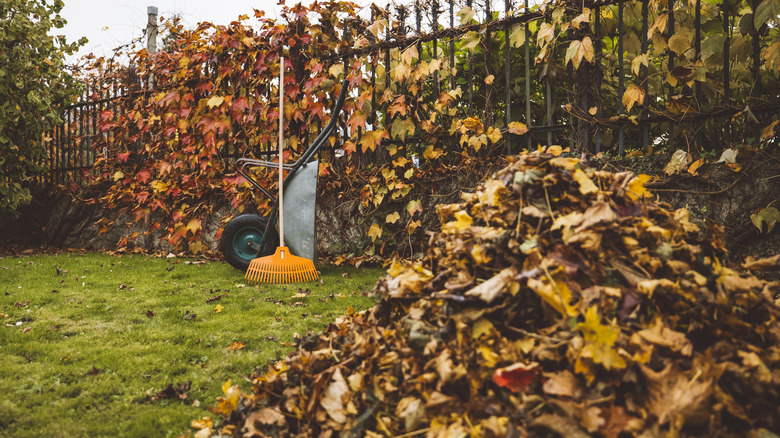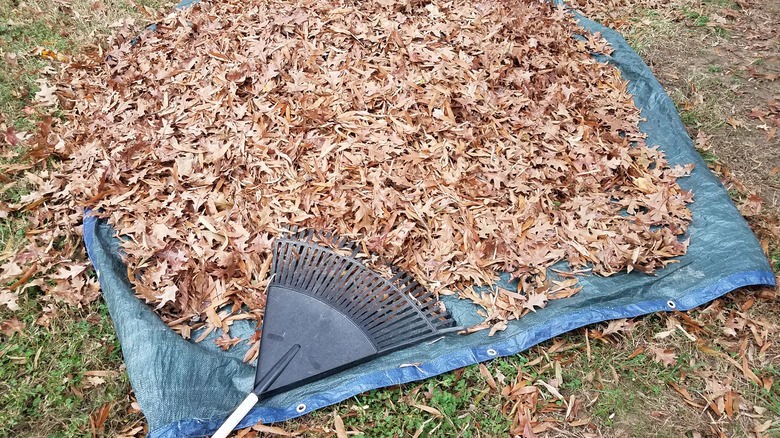Give Your Lawn A Good Stomping If You Can't Quite Finish Raking Leaves
Even people who love autumn foliage colors probably aren't as excited when the leaves land on the ground and require raking. Although multiple tips exist for making raking the leaves in your yard easier, it's still a tough chore. The last thing you want is to do it more than once. Maybe you finish three-quarters of the job before dark, resulting in several beautiful piles. By the following day, though, strong winds – or perhaps the neighbor's kids – have scattered the leaves back across your grass. If you cannot finish the raking in one session, you have a few options for keeping the leaves from blowing around and foiling your efforts – without bagging them – until you can return.
One of the most useful options is to let the family jump and stomp on the leaves to compact them, preventing the wind from grabbing them as easily. As you rake the leaves into large piles, the ones on the bottom will avoid being scattered because of the weight of the upper portion. However, those leaves near the top could blow away, forcing you to rake again. Create less surface area on the pile for the wind to catch by stomping on the leaves to compact them and keep them from dispersing across the lawn again. As you and the family stomp and jump, try to keep the leaves on the pile rather than letting them fly away from the force of your exertions.
How to position your leaves to keep them from blowing around
As an added benefit of jumping and stomping, you'll create tiny leaf pieces that can fall to the soil and provide nutrients for the lawn the following spring while you remove the larger pieces later. This idea may have you wondering whether raking dead leaves is really necessary. Couldn't you leave the full-size pieces to deliver the same nutrients? It turns out full-size leaves can smother the grass if left in place. Additionally, tiny pieces will decompose in about one year, while larger pieces can require up to three years.
If you plan to use the fallen leaves as mulch for vegetable gardens, flower gardens, or around your trees, rake them directly onto these areas. Spread them around where you want them and where they won't block or damage any existing plants. Usually, up to 4 inches of leaf height is ideal for mulching. Then, stomp on them to compact and break them up, taking care not to step on the plants already in the garden. Should the leaves still blow around a bit until you can return to the job, at least they'll be close to the areas where you want them.
Create your leaf piles in areas where it's easier to stomp them
To further help with having fewer leaves fly off your piles when you have to step away from the job, create the mounds near your home, garage, or fence. Then stomp on them in those areas. If the space behind your garage has some protection from the wind, even better. Try to move the leaves and create piles in the same direction the wind normally blows in autumn, so if any leaves do escape your piles, they will pin against a fence or building, keeping them nearby. Additionally, plan your raking for a few days in a row where the wind will be light to avoid issues.
If you'd like to crush the leaves effectively without having to mow or shred them with a machine so you can use the smaller pieces as nutrients, rake everything onto a tarp. Then, use 2x4s or wooden dowels to hold down the ends. Fold the tarp upon itself and then begin stomping. The wood holds the ends in place so crushed leaves can't escape, making your efforts more effective so they decompose faster. Additionally, if you use a heavyweight material for the tarp, like canvas, or place rocks on top, it will protect the leaves from wind until you return.


